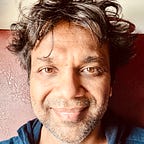FactorDaily and The Stone Whisperer of Turtuk
By Pankaj Mishra
Whispers by the River
In Turtuk, a village cradled by Leh’s majestic landscapes, I met Ghulam Mohammed in April 2018. His workshop, a simple structure under a tin roof, sat by the Shyok River, whose waters whispered stories as old as the Himalayas. Ghulam, a stone craftsman, didn’t just shape stone; he wove stories into them, a skill passed down from his father.
Legacy in Stone
Ghulam’s father, a man whose soul danced with the mountain goats and birds, had a deep bond with nature. This connection to nature infused his work, elevating it from functional creations to sculptures that captured the essence of the Ladakhi landscape. Together, they crafted cooking bowls, intricate tea sets, pressure cookers (yes, pressure cookers made of stone!), and vivid scenes of snow leopards in pursuit, each piece a narrative in stone.
Continuing this legacy, Ghulam works in his studio by the Shyok River, often with his young son by his side.
One afternoon, as the sun cast long shadows over the river, Ghulam shared a truth with me. “Sometimes,” he said, “a tiny error can make the stone crack right at the end of a month’s work. It’s a hard lesson in letting go and starting over.”
This confession from Ghulam struck a chord deep within me. It’s a reminder that impactful narratives, whether in stone or words, are those crafted with care, time, and a deep connection to our roots.
Ghulam had recently found a new project to create stone sinks for a series of villas. Each sink, carved from a single rock, was a piece of art that symbolized the beauty in slow, mindful creation.
It took him two years to cut the 16 sculpted sinks!
As the day passed and shadows grew longer, I reflected on the parallels between Ghulam’s art and my journey in journalism. Like his careful chiseling, we aim to craft stories with precision and heart. In an era where speed is often prized over depth, his work and our journalism at FactorDaily remind us of the beauty and value of taking time.
A Still Melody
Amidst the sounds of chisels and the river’s song, there was another melody in Ghulam’s workshop — the laughter of his young son. The boy, a bundle of joyous energy, mirrored the river’s spirit — pure, lively, and unbridled. He darted around the workshop, his giggles echoing off the stone walls, his tiny feet stirring up the dust as he played by the river’s edge.
Yet, in his playful chaos, there were moments of stillness when the child looked at his father. It was a mesmerizing sight — the boy, so full of life and movement, suddenly transfixed by the slow dance of Ghulam’s hands shaping stone.
Watching them, I was struck by the contrast and harmony between father and son. In Ghulam’s steady hands, there was a story of resilience, a craft honed over years of patient toil. In his son’s wide-eyed wonder was the story of the future, of possibilities yet to unfold.
The Artisan’s Hands: Dust and Dreams
Ghulam’s hands told a story of their own, a narrative soaked in dust and time. They were always covered in a fine layer of stone dust, the residue of his relentless carving. I noticed he never dusted them off; it was as if the dust was a part of him, a testament to his dedication. The dust clung to his skin, settled in the creases of his palms, and under his nails — a permanent reminder of his bond with the stone.
Ghulam’s relationship with the dust reflected an artisan’s bond with their medium. For Ghulam, the dust was not merely a byproduct but an integral part of his creative journey, a tangible connection to the stone and the earth. Similarly, journalism’s overwhelming flow of information is not just a hurdle; it’s fertile ground for our narratives, a source where we discover and nurture stories that enlighten and connect.
As I stood there, watching the dust swirl around Ghulam’s workshop, illuminated by the slanting rays of the setting sun, I felt a deep connection to this artisan. Our crafts were different, yet they were bound by a common thread — a love for the material we worked with, whether stone or stories and a commitment to shaping it into something meaningful.
In Ghulam’s dusty hands, I saw the beauty of an artisan’s bond with their craft. In the dust of journalism, I saw the raw material of understanding and insight. Both were a reminder of the beauty in the process, in the slow and careful transformation of the raw into the refined, the chaotic into the coherent.
Whispers in stone
And then, as I prepared to leave, Ghulam’s son ran up to his father, his tiny hand grasping a pebble from the riverbank. He offered it to Ghulam as if presenting a treasure. Ghulam accepted it with a gentle smile, holding it up to the light. In that simple stone, in that quiet moment of connection between father and son, I saw the essence of our shared humanity — the stories we pass on, the timeless bond between creation and creator, between past and future.
In “The Stone Whisperer of Turtuk,” I found not just a craftsman but a living embodiment of the power of stories — stories that, like the river, flow through the heart of our existence, shaping us, guiding us, and reminding us of the beauty in the slow, deliberate art of living.
“To be yourself in a world that is constantly trying to make you something else is the greatest accomplishment.”
